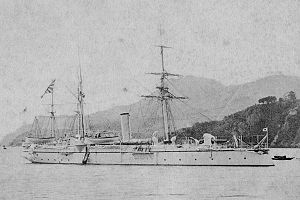Japanese gunboat Chōkai

Japanese gunboat Chōkai at Sasebo, 1889
|
|
| History | |
|---|---|
|
|
|
| Name: | Chōkai |
| Ordered: | 1883 |
| Builder: | Ishikawajima-Hirano Shipyards |
| Laid down: | 25 January 1886 |
| Launched: | 20 August 1887 |
| Commissioned: | 27 December 1888 |
| Decommissioned: | 1 April 1908 |
| Struck: | 23 May 1911 |
| Fate: | scrapped 1912 |
| General characteristics | |
| Class and type: | Maya-class gunboat |
| Displacement: | 614 long tons (624 t) |
| Length: | 47.0 m (154.2 ft) |
| Beam: | 8.2 m (26 ft 11 in) |
| Draught: | 2.95 m (9 ft 8 in) |
| Propulsion: |
|
| Speed: | 11.0 knots (12.7 mph; 20.4 km/h) |
| Range: | 60 tons coal |
| Complement: | 104 |
| Armament: |
|
| Service record | |
| Operations: | |
Chōkai (鳥海?) was an iron-hulled, steam gunboat, serving in the early Imperial Japanese Navy. She was the second vessel to be completed in the four vessel Maya class, and was named after Mount Chōkai in between Yamagata and Akita Prefectures.
Chōkai was an iron-hulled, two-masted gunboat with a horizontal double expansion reciprocating steam engine with two cylindrical boilers driving two screws. She also had two masts for a schooner sail rig.
Chōkai was laid down at the Ishikawajima-Hirano Shipyards in Tokyo on 1 January 1886 and launched on 20 August 1887. She was completed on 27 December 1888.
Chōkai was captained by Lieutenant Commander Kamimura Hikonojō from October 1893 to June 1894. Chōkai saw combat service in the First Sino-Japanese War under the command of Lieutenant Commander Tōgō Masamichi, patrolling between Korea, Dairen and played a role at the Battle of Weihaiwei. On the night of 5 February, Chōkai participated in a night operation with Atago, in which the gunboats made a feint attack on the north entrance to the harbor as a diversion while torpedo boats attacked from the east entrance, sinking the Chinese battleship Dingyuan and damaging the cruiser Laiyuan. After the surrender of China, Atago and Chōkai remained at Weihaihei as part of the Japanese occupation force.
...
Wikipedia
